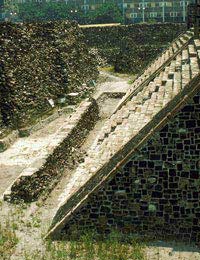
To many people the word Aztec conjures up images of plentiful gleaming gold and Mesoamerican Indians in rich costumes performing ritualistic dances. Although this is the common depiction in books and films the archaeologist finds little of the colour gold or dancing when the digging fields of this Pre-Columbian people of central Mexico are excavated.
The Mexicas
The Aztecs built an extensive post-classic period empire and called themselves Mexicas. The centre of the empire was at the Valley of Mexico where they constructed their capital, Tenochtitlan, which was built upon raised beds in the Texcoco lake.
Discoveries of their Way of Life
Archaeologists are very interested in this Mesoamerican culture as it was a late civilisation that appears to have developed without much influence from foreign intervention. It is a civilisation that began around AD 1195 and continued until 1522 when the Spanish destroyed their capital and declared the newly built city a colony of Spain.
Food and Drink
Maize was the Aztec staple food but could not be grown in a lake. The capital was built on an island in the middle of the Lake Texcoco. There was no useable farming land in the near vicinity and the Aztecs invented a method to create their own farmland. The peasant workers wove huge reed mats that were laid out on top of the lake water. Fences were built around the mats to contain the infill of lake mud, silt, and vegetation. Quick growing, water sucking, willow trees were planted surrounding the fenced perimeter. The resultant islands, albeit small, were sufficient for the farmers to grow corn, potatoes, tomatoes, peppers, and squash. The trees became a natural siphon that drained the swampland. Heavy penalties were imposed on those who tampered with the trees.
Archaeologists have discovered no agricultural tools, such as ploughs or wheeled apparatus, due to the soft soil conditions only requiring simple wooden stick tools. Few of these wooden artefacts have survived in the marshland conditions.
The cocoa bean was widely grown and chocolate was considered a delicacy reserved for the warriors and noble classes. Alcohol, made from a local plant, was forbidden to all except nobles and royalty. Apart from fruit and vegetables, palaeontologists have discovered sufficient bone evidence to know that dogs and birds were also on the Aztec menu.
Aztec Medicine
The Aztec remedies for cure and prevention of illness was primarily herbal. However, the central Mexican religious beliefs influenced much in their medicine and often caused remedies to be more harmful than beneficial.
According to archaeological evidence, fevers were thought to be an attack by evil spirits and that a hot steam bath would sweat out the malevolent intruder. Expectant mothers needed to carry a portion of wood ash to ward off after-dark-ghosts or the child could be harmed. Cuts to the leg were filled with powdered glass.
Laws and Politics
The Aztecs had a political system that operated with harsh punishments. The Great Speaker was head of the court, priesthood, and the armed forces. Like many earlier European and Eastern emperors, he was thought to be a human god and could interact with the other Aztec gods.
Although the Aztecs seem to have had a justice system not unlike modern western nations, with a judge and a community jury, once an accused was before the court it was unlikely he would be dismissed.
Archaeologists have discovered numerous written artefacts that describe the crimes and punishments of the Aztec culture:
Treason: Death, all your property sold, family sold as slaves
Adultery: Death
Peasant wearing cotton: Death
Chopping down a living tree: Death
Moving a boundary marker: Death
Serious Theft: Death
Drunkenness:
- First time: Head shaved, house destroyed
- Second time: Death
Minor Theft: Sold as a slave